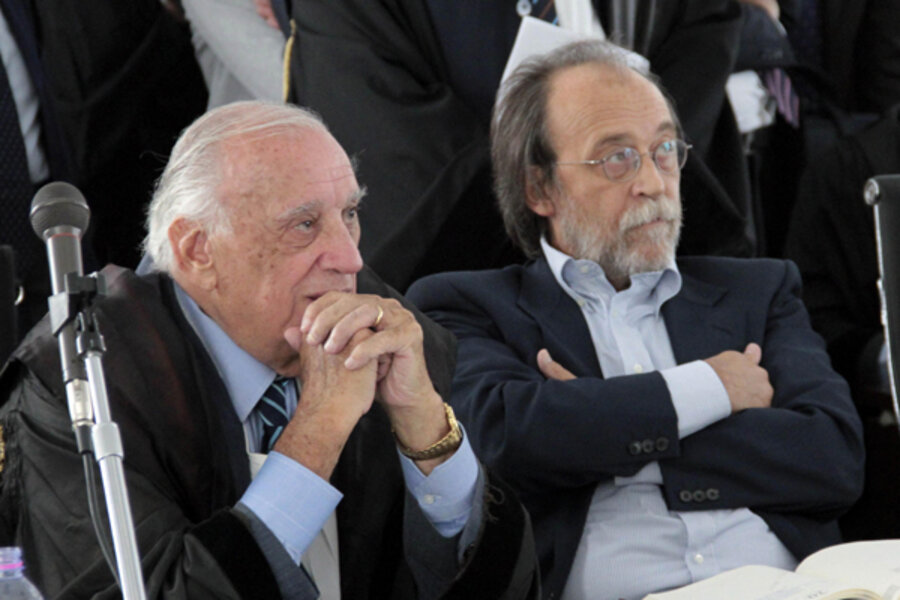Italian scientists' failure to predict 2009 quake: a criminal offense? (video)
Loading...
| Milan, Italy
Almost a year and a half after a 6.3 magnitude earthquake shook central Italy – leaving more than 300 dead and the medieval town of L'Aquila in rubble – seven scientists are being charged with manslaughter in what some have described as a trial against science itself.
The public prosecutor claims that the seven experts falsely reassured the public that there was “no danger” of a major quake in the near future in a public statement issued just six days ahead of the April 9, 2009, disaster, and are thus accountable for many deaths. Victims of the quake are also bringing civil claims against the scientists totaling 50 million euros ($68.2 million), the ANSA news agency reported.
Yet the scientific community worldwide has been outraged by the allegations, which are perceived as an attempt to scapegoat the tragedy on a group of scientists who supposedly should have foreseen it.
Thomas H. Jordan, the director of the Southern California Earthquake Center who also chaired an international panel appointed by the Italian government after the 2009 quake, wrote an article in The New Scientist in defense of his colleagues on trial.
“There is no known method to predict earthquakes with high probability,” he wrote. He also stressed the need to “separate the role of science advisers, whose job is to provide objective information about natural hazards, with that of civil decision-makers who must weigh the benefits of protective actions against the costs of false alarms."
In the months ahead of the April 9 tremor, a wave of minor quakes – a phenomenon known as a “seismic swarm” – were registered across central Italy, not far from L'Aquila. Giampaolo Giuliani, a man from the area who worked as researcher in a geo-physics laboratory (though not a seismologist himself), began warning his fellow citizens in L'Aquila that a major tremor was coming.
[ Video is no longer available. ]
Concerned with the perspective of a widespread panic outburst, local authorities established a panel of seven scientists – a team of seismologists and other experts working for the Civil Protection Department, which organizes efforts to forecast and prevent catastrophes – in order to assess if there was any real cause for alarm.
On March 31, the panel issued a statement, broadcasted by the local television station, according to which the seismic swarm posed “no threat.” Six days later, L'Aquila was destroyed.
Within hours, Mr. Giuliani became a national hero and the authorities were blamed for having wrongly dismissed his alarm. But even now, most scientists view his warning as a coincidence. In March 2009, Giuliani told a local TV he could predict a major tremor was on the way because of unusual radon activities – but so far no scientist has successfully demonstrated that monitoring radon, a naturally occurring radioactive gas, can be used to predict when an earthquake will strike.
Therefore, some wonder how can scientists held accountable for the more than 300 deaths caused by the quake. “To me it looks like a witch hunt, this is a useless and stupid trial,” says Maurizio Tortorella, deputy editor of Panorama magazine and one of Italy's best known legal affairs commentators.
Although he agrees that the statements made by the seven scientists panel ahead of the April 2009 quake “was probably too reassuring,” Mr. Tortorella says that there's no way scientists can be held accountable for such a catastrophe.
“To begin with, we know that predicting earthquakes, it's impossible," he says. "But let's assume they could have foreseen it, then what could they have done? Evacuate the whole city of L'Aquila? Of course [a panel of scientists] could not take such a responsibility.”
Should anyone be put on trial, argues Tortorella, it should be “those who have built houses without respecting the anti-seismic laws.” While L'Aquila was mostly a medieval city of centuries-old buildings, many recently built houses were also destroyed by quake. Those buildings, including a university dormitory where eight students lost their lives, were later found not to conform to modern anti-seismic standards.





